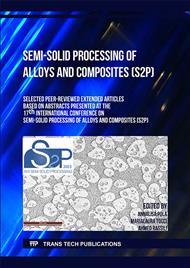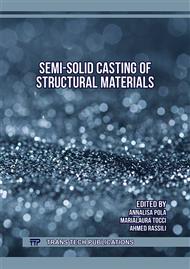[1]
D.B. Spencer, R. Mehrabian, M.C. Flemings, Rheological behavior of Sn-l5%Pb in the crystallization range, Metall. Trans. 3 (1972)
DOI: 10.1007/bf02642580
Google Scholar
[2]
M.C. Flemings, Behavior of metal alloys in the semisolid state, Metall. Trans. 22A (1991) 957-981.
DOI: 10.1007/bf02661090
Google Scholar
[3]
S. Brown, P. Kumar, C.L. Martin, Shear rate thickening behavior of semisolid slurries, Metallurgical Transactions A 24 (1993) 1107-1116.
DOI: 10.1007/bf02657241
Google Scholar
[4]
M. Suéry, C.L. Martin, L. Salvo, Overview of the rheological behavior of globular and dendritic slurries, Proceedings of the Fourth International Conference on Semisolid Processing of Alloys and Composites, Conference Proceedings, 19-21 June 1996, Sheffield, UK, pp.21-29.
Google Scholar
[5]
A. Pola, M. Tocci, P. Kapranos, Microstructure and properties of semisolid aluminum alloys: A literature Review. Metals 2018 8 (3), 181.
DOI: 10.3390/met8030181
Google Scholar
[6]
Megalingam, A. Ahmad, A. H., Application of response surface methodology for parameter optimization of aluminum 7075 thixoforming feedstock billet production. Journal of Materials Engineering and Performance 19-17 (2022)
DOI: 10.1007/s11665-022-07535-4
Google Scholar
[7]
A. Zavaliangos et al, Physical mechanisms of the flow resistance of semisolid materials at high volume fraction of solid, Proceedings of the Fourth International Conference on Semisolid Processing of Alloys and Composites, Conference Proceedings, 19-21 June 1996,Sheffield, UK, pp.40-46.
Google Scholar
[8]
A. Alexandrou, Three-dimensional flow of thixotropic materials in a channel with a sudden expansion using a phenomenological constitutive relation, Proceedings of the 1996, TMS Light Metals Session, February 1996, Anaheim, CA, p.807.
Google Scholar
[9]
Jinlong Fu, Kaikun Wang. Modeling and simulation of die casting process for A356 semisolid alloy. Procedia Engineering 81 1565- 1570 (2014).
DOI: 10.1016/j.proeng.2014.10.191
Google Scholar
[10]
P. Zheng, J. Xu, Z.F. Zhang, Y.L. Bai, L.K. Shi. Numerical Simulation of Filling of Rheo-diecasting A357 Aluminum Alloy Special Casting and Nonferrous Alloys, 30 (1) (2010), pp.43-48
Google Scholar
[11]
Y. J. Zhang, W.M. Mao, Z.D. Zhao, Z. Liu. Rheological Behavior of Semi-solid A356 Aluminum Alloy at Steady State ACTA Metallurgica Sinica, 42 (2) (2006), pp.163-166.
Google Scholar
[12]
Zhang, F., TBR Rheo-diecasting Mechanism and Numerical simulation on Forming Defect of A356 Aluminum alloy. Masther Thesis Beijing. University of Science and Technology Beijing. (2011)
Google Scholar



